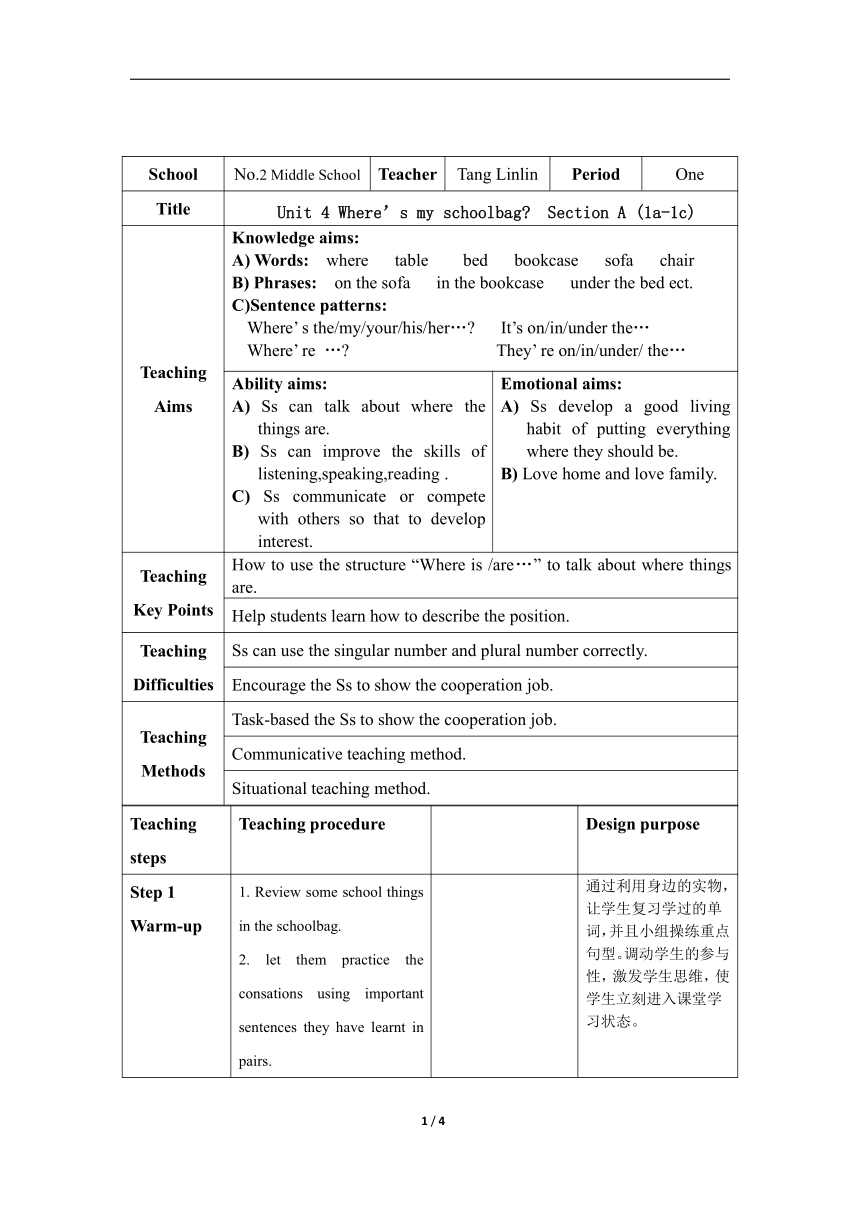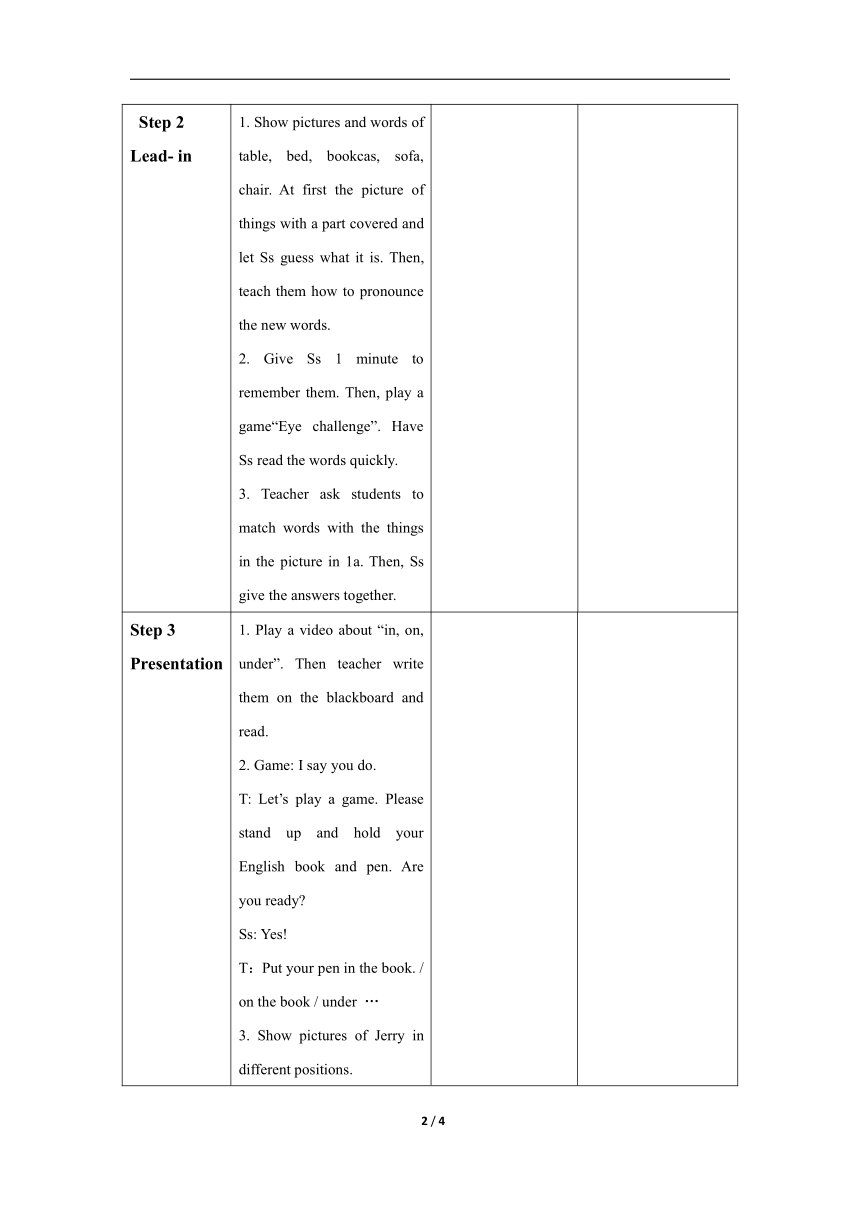Unit 4 Where's my schoolbag? Section A (1a-1c)公开课表格式教案
文档属性
| 名称 | Unit 4 Where's my schoolbag? Section A (1a-1c)公开课表格式教案 |  | |
| 格式 | zip | ||
| 文件大小 | 59.0KB | ||
| 资源类型 | 教案 | ||
| 版本资源 | 人教新目标(Go for it)版 | ||
| 科目 | 英语 | ||
| 更新时间 | 2020-02-07 14:43:31 | ||
图片预览


文档简介
School No.2 Middle School Teacher Tang Linlin Period One
Title Unit 4 Where’s my schoolbag? Section A (1a-1c)
Teaching Aims Knowledge aims:A) Words: where table bed bookcase sofa chair B) Phrases: on the sofa in the bookcase under the bed ect.C)Sentence patterns:Where’ s the/my/your/his/her…? It’s on/in/under the…Where’ re …? They’ re on/in/under/ the…
Ability aims:A) Ss can talk about where the things are.B) Ss can improve the skills of listening,speaking,reading .C) Ss communicate or compete with others so that to develop interest. Emotional aims:A) Ss develop a good living habit of putting everything where they should be.B) Love home and love family.
TeachingKey Points How to use the structure “Where is /are…” to talk about where things are.
Help students learn how to describe the position.
TeachingDifficulties Ss can use the singular number and plural number correctly.
Encourage the Ss to show the cooperation job.
TeachingMethods Task-based the Ss to show the cooperation job.
Communicative teaching method.
Situational teaching method.
Teaching steps Teaching procedure Design purpose
Step 1Warm-up 1. Review some school things in the schoolbag. 2. let them practice the consations using important sentences they have learnt in pairs. 通过利用身边的实物,让学生复习学过的单词,并且小组操练重点句型。调动学生的参与性,激发学生思维,使学生立刻进入课堂学习状态。
Step 2 Lead- in 1. Show pictures and words of table, bed, bookcas, sofa, chair. At first the picture of things with a part covered and let Ss guess what it is. Then, teach them how to pronounce the new words. 2. Give Ss 1 minute to remember them. Then, play a game“Eye challenge”. Have Ss read the words quickly. 3. Teacher ask students to match words with the things in the picture in 1a. Then, Ss give the answers together.
Step 3Presentation 1. Play a video about “in, on, under”. Then teacher write them on the blackboard and read.2. Game: I say you do.T: Let’s play a game. Please stand up and hold your English book and pen. Are you ready? Ss: Yes! T:Put your pen in the book. / on the book / under …3. Show pictures of Jerry in different positions. T: Where is Jerry? S: It’s on/in/under the case. (lead in the target language) 4. Show some pictures on the screen, talk about where things are by using the sentences structures “Where is…? Where are…? ” “It is / They are in/on/under….” Divide students into groups of two and make conversations based on the pictures the teacher showed in the ppt.
Step 4Listening Teacher ask Ss to listen and number the things in the picture for the first time. Then listen again, fill in the blanks. At last, check the answer with Ss.
Step 5Game 1. ⑴ Let one student hide something, then another student look for it, if he/she close to the thing, other students clap your hands, if far away, others say “yi”.⑵ The teacher hide something, let one or two students look for it/them. 2. The strongest brain: Look at Tom’s room for 1 minute, then tell us where the things are.
Step 6Emoional education Show an untidy picture and a tidy one, compare them and ask Ss “Which picture do you like?”
Step 7Summary T: Let’s take a short review of words and sentence patterns.
Step 8Homework 1. Memorize the key words by heart. 2. Make conversations with the target language. -Where is…? - It is … -Where are…? -They are… 3. Preview P20-21: make preparations for the next period.
Step 9Blackboarddesign Unit?4 ??Where’s?my?schoolbag? ??Section?A?(1a--1c)table in A: Where is the sofa on B: It’s in/on/under chair under A: Where are the bed B: They’re in/on/under bookcase
Teaching reflection
12 / 12
同课章节目录
- starters 预备篇(2012秋审查)
- Unit 1 Good morning !
- Unit 2 What’s this in English?
- Unit 3 What color is it ?
- Unit 1 My name's Gina.
- Section A
- Section B
- Unit 2 This is my sister.
- Section A
- Section B
- Unit 3 Is this your pencil?
- Section A
- Section B
- Unit 4 Where's my schoolbag?
- Section A
- Section B
- Unit 5 Do you have a soccer ball?
- Section A
- Section B
- Unit 6 Do you like bananas?
- Section A
- Section B
- Unit 7 How much are these socks?
- Section A
- Section B
- Unit 8 When is your birthday?
- Section A
- Section B
- Unit 9 My favorite subject is science.
- Section A
- Section B
